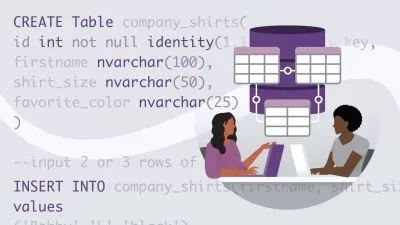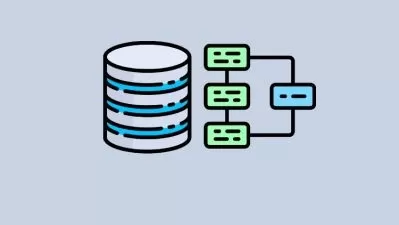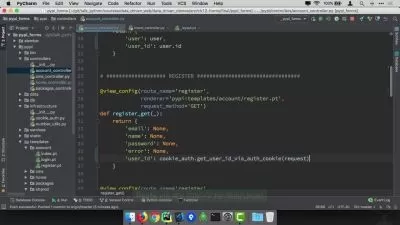SQL Queries 101: A Beginner's Guide to Data Retrieval
Sunil Nair
2:23:02
Description
Building a Strong Foundation in SQL Query Writing
What You'll Learn?
- Use of Scalar functions to manipulate or compute values for individual rows of a result set
- Use of Aggregation Functions allowing you to summarize and compute statistics on data, providing valuable insights into trends and patterns.
- Joins to combine data from multiple tables, enabling to perform more complex queries and gain insights from related datasets.
- Subqueries as a means of filtering data based on the results of another query or performing calculations
Who is this for?
What You Need to Know?
More details
DescriptionIf you are a student or working professional, join me in this engaging beginner course on SQL Queries. This course will teach you how to write SQL Queries for effortless data retrieval with a minimal learning curve.
As of October 2023, I have provided in-person training to over 3,000 professionals, covering skills such as office productivity, programming, databases, analytics, and cloud computing, which enables rapid integration of newfound skill sets.
Course Curriculum
Basic SELECT Statement
Scalar Functions
Aggregates
GROUP BY and HAVING Clause
Comparison and Logical Operators
Table Relationships with JOINS
Sub Queries
Case Switch
SQL Views
CREATE Table
INSERT, UPDATE and DELETE Rows
What this course contains
11 Sections with Easy-to-follow instructional videos
2 Quizzes
Software and Credentials Required
You can install SQL Server Basic along with SQL Server Management Studio.
Alternatively, if you cannot install SQL Server, you may utilize the website SQLiteonline to execute the SQL queries relevant to this course.
Intended Course Outcome
Data Retrieval: Mastering SQL SELECT queries allows learners to efficiently access specific data from one or multiple database tables, ensuring quick and accurate information retrieval.
Data Filtering: Users can employ filtering conditions in SQL SELECT queries using the WHERE clause, enabling data extraction that meets particular criteria, such as date ranges, categories, or values.
Data Sorting: Utilizing SQL SELECT queries, retrieved data can be sorted in ascending or descending order based on one or more columns, simplifying analysis and presentation.
Data Aggregation: Proficiency in SQL SELECT queries empowers users to perform calculations and use aggregate functions (e.g., SUM, AVG, COUNT) on selected data, offering valuable insights and information summaries.
Data Joining: By mastering SQL JOIN clauses, learners can merge data from multiple related tables, promoting extensive data analysis and reporting.
Who this course is for:
- Data and Business Analysts
- Software Developers
- Data Scientists
- Quality Assurance/Testers
- IT Professionals
- Entrepreneurs and Small Business Owners
- Students and Aspiring Data Professionals
- Anyone interested in Data
If you are a student or working professional, join me in this engaging beginner course on SQL Queries. This course will teach you how to write SQL Queries for effortless data retrieval with a minimal learning curve.
As of October 2023, I have provided in-person training to over 3,000 professionals, covering skills such as office productivity, programming, databases, analytics, and cloud computing, which enables rapid integration of newfound skill sets.
Course Curriculum
Basic SELECT Statement
Scalar Functions
Aggregates
GROUP BY and HAVING Clause
Comparison and Logical Operators
Table Relationships with JOINS
Sub Queries
Case Switch
SQL Views
CREATE Table
INSERT, UPDATE and DELETE Rows
What this course contains
11 Sections with Easy-to-follow instructional videos
2 Quizzes
Software and Credentials Required
You can install SQL Server Basic along with SQL Server Management Studio.
Alternatively, if you cannot install SQL Server, you may utilize the website SQLiteonline to execute the SQL queries relevant to this course.
Intended Course Outcome
Data Retrieval: Mastering SQL SELECT queries allows learners to efficiently access specific data from one or multiple database tables, ensuring quick and accurate information retrieval.
Data Filtering: Users can employ filtering conditions in SQL SELECT queries using the WHERE clause, enabling data extraction that meets particular criteria, such as date ranges, categories, or values.
Data Sorting: Utilizing SQL SELECT queries, retrieved data can be sorted in ascending or descending order based on one or more columns, simplifying analysis and presentation.
Data Aggregation: Proficiency in SQL SELECT queries empowers users to perform calculations and use aggregate functions (e.g., SUM, AVG, COUNT) on selected data, offering valuable insights and information summaries.
Data Joining: By mastering SQL JOIN clauses, learners can merge data from multiple related tables, promoting extensive data analysis and reporting.
Who this course is for:
- Data and Business Analysts
- Software Developers
- Data Scientists
- Quality Assurance/Testers
- IT Professionals
- Entrepreneurs and Small Business Owners
- Students and Aspiring Data Professionals
- Anyone interested in Data
User Reviews
Rating
Sunil Nair
Instructor's Courses
Udemy
View courses Udemy- language english
- Training sessions 41
- duration 2:23:02
- Release Date 2024/01/13














